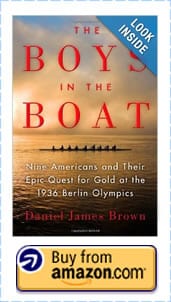Click here to buy The Boys in the Boat now.
One of our clients (thanks Dan!) recommended this book to me and for me, it was my number one favorite book read this year (and possibly over the last few years – yes, it is that good). I highly, highly recommend it. It is beautifully written, is a true story, shares incredible insight into those involved, has historical Olympic significance and covers all the bases on what makes a truly great read. The author, Daniel James Brown is a masterful writer.
What the Boys in the Boat is About
 The book tells the story of the University of Washington’s eight rowing crew and their epic quest for gold at the 1936 Olympics. This crew transformed the sport of rowing, overcame enormous odds and grabbed the attention and hearts of their nation. The crew had to first battle within their own country for selection as the USA Crew, to beat the elite eastern universities on the water and overcome the enormous financial hurdles in their way. Being made up of sons of loggers, shipyard workers, and farmers, their personal stories are inspirational.
The book tells the story of the University of Washington’s eight rowing crew and their epic quest for gold at the 1936 Olympics. This crew transformed the sport of rowing, overcame enormous odds and grabbed the attention and hearts of their nation. The crew had to first battle within their own country for selection as the USA Crew, to beat the elite eastern universities on the water and overcome the enormous financial hurdles in their way. Being made up of sons of loggers, shipyard workers, and farmers, their personal stories are inspirational.
Drawing on the crew members’ own diaries and journals, their photos and memories of a once-in-a-lifetime shared dream, the Boys in the Boat is an irresistible story about beating the odds and finding hope in the most desperate of times – the improbable, intimate story of nine working-class boys from the American west who, in the depths of the Great Depression, showed the world what true grit really meant.
The emotional heart of the story lies with one rower, Joe Rantz, a teenager without family or prospects, who rows not for glory, but to regain his shattered self-regard and to find a place he can call home. The crew is assembled by an enigmatic coach and mentored by a visionary, eccentric British boat builder, but it is their trust in each other that makes them a victorious team. They remind the country of what can be done when everyone quite literally pulls together—a perfect melding of commitment, determination, and optimism.
My favorite page of the Boys in the Boat
Below is an extract from the chapter “The Parts That Really Matter”, on page 139:
“The team effort – the perfectly synchronized flow of muscle, oars, boat and water; the single, whole, unified, and beautiful symphony that a crew in motion becomes – is all that matters. Not the individual, not the self.
The psychology is complex. Even as rowers must subsume their often fierce sense of independence and self-reliance, at the same time they must hold true to their individuality, their unique capabilities as oarsmen or oarswoman or, for that matter, as human beings. Even if they could, few rowing coaches would simply clone their biggest, strongest, smartest, and most capable rowers. Crew races are not won by clones.
They are won by crews, and great crews are carefully balanced blends of both physical abilities and personality types. In physical terms, for instance, one rowers arms might be longer than another’s, but the latter might have a stronger back than the former. Neither is necessarily a better or more valuable oarsman than the other; both are assets to the boat. But if they are to row well together, each of these oarsmen must adjust to the needs and capabilities of the other. Each must be prepared to compromise something in the way of optimizing his stroke for the overall benefit of the boat – the shorter-armed man reaching a little farther, the longer-armed man foreshortening his reach a bit- so that both men’s oars remain parallel and both blades enter and exit the water at precisely the same moment. This highly refined coordination and cooperation must be multiplied out across eight individual’s strengths.
Only in this way can the capabilities that come with diversity – lighter, more technical rowers in the bow and stronger, heavier pullers in the middle of the boat, for instance-be turned to advantage rather than disadvantage.
And capitalizing on diversity is perhaps even more important when it comes to characters of oarsmen, a crew composed entirely of eight amped-up, overly aggressive oarsmen will often degenerate into a dysfunctional brawl in a boat or exhaust itself in the first leg of a long race. Similarly, a boatload of quiet but strong introverts may never find the common core of fiery resolve that causes the boat to explode past its competitors when all seems lost. Good crews are good blends of personalities: someone to lead the charge, someone to hold something in reserve; someone to pick a fight, someone to make peace; someone to think things through, someone to charge ahead without thinking. Somehow all this must mesh. That’s the steepest challenge.”
We hope you found this Book Review valuable and are also inspired to read this phenomenal book. You may also enjoy our other Book Reviews.
At Athlete Assessments, we’re here to provide you with excellence in service and here to help you be your best. If there is anything we can assist you with, please Contact Us.





